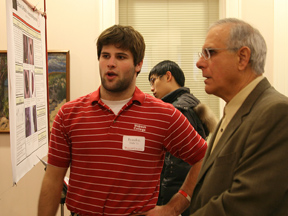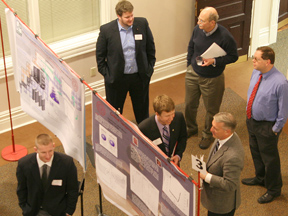In the summer of 2008, rhetoric students Grant Gussman and Daniel King entered Fine Arts 206 with Professor of Rhetoric David Timmerman. Each spent four weeks watching and reading The Boondocks, analyzing the rhetorical aspects in the comic strip and television show.
“We had each heard the others’ perspective in bits and pieces,” Timmerman said, “but we had arrived at a crunch moment.” To joint-write and release their paper, the three scholars needed to agree on a thesis, yet each saw different rhetorical principles as important.
To Timmerman, this moment served as a dramatic climax.
“First Grant stood before Daniel and me, and waxed eloquently for 10 minutes making the case. Then I stood up, doing the same, shifting the focus from Grant’s presentation. Finally Daniel did this—and he wisely took the wooden pointer to add to his credibility.”
Gussman, King, and Timmerman ultimately found common ground for their research project. After more disagreements and revisions, the group displayed their work alongside the work of fellow Wabash students at last year’s Celebration of Student Research.

The Wabash College Celebration of Student Research, which will be held January 29, 2010, gives Wabash students in all disciplines an avenue for displaying their academic work and personal interests and talents. “Wabash men do some amazing things, but we rarely get to see so much excellence displayed at once,” said Professor of Mathematics Chad Westphal, who is also on the faculty committee organizing the celebration.
The set-up of the Celebration brings together wide varieties of research topics together in one event. From 1 p.m. to 4 p.m., students observe poster projects, listen to 15-20 minute oral presentations, and examine visual art and photojournalism displays.
“Some academic disciplines tend to more naturally lend themselves to one style of presentation over another,” Westphal said. “The sciences, for example, tend to do more posters, and the humanities tend to do more oral presentations. But this is completely up to the student and his faculty/staff sponsor.”

King noted how The Boondocks project broadened from his original assignment for Rhetoric 270: Rhetoric and Humor. “Conducting research is a time when students can be creative and synthesize theories and ideas across academic disciplines,” he said.
Their project argued that the show uses dialogue, visual art drawn from Japanese animé, and music to “critique the hypocritical, misogynist, and homophobic behavior present in the African-American community.”
The Celebration defines how students can take faculty and student interaction to a new level.
“Wabash students work with Wabash professors every day in class,” said Timmerman, “When professors and students get the opportunity to work together outside of class, that is icing on the cake.”
Funding from the Center of Inquiry in the Liberal Arts allowed Gussman and King to work with Professor Timmerman on campus in the summer. “I felt as if I was able to bring two things I love together,” said Timmerman, “teaching and scholarly research.”
The college distributes other grant money for broad ranges of study, notably the Kenneth Rudolph award for summer study in Europe as well as the Givens award to study Western art.
Gussman, King, and Timmerman’s work garnered much positive response from their fellow students. “Some students were more excited than we were,” King said. Westphal noticed this across all projects. “[The Celebration] is a great time for the whole campus to rally around the common goal of intellectual exploration, and to stop and look around at what others are doing.”
Wabash research projects go far beyond the scope of the Celebration. Gussman, King, and Timmerman submitted their project to the Critical Studies in Media Communication journal. The journal’s acceptance of their work brought about critical reviews of their work. One review stated, “I can imagine assigning [this] in my undergraduate classes.” The group plans to revise their paper and re-submit it for additional scrutiny and publication.
“Writing The Boondocks paper taught me how much work and effort it takes to prepare a paper for publication,” King said. “I have a better idea of the process of what happens after academics submit a paper to a journal. It’s a long process, but it’s rewarding in the end.
“If you’re an underclassman, I really encourage that you approach your favorite professor and ask to participate in research. I’m sure that professor will be excited, especially if you have an original idea.”
 The Wabash College Celebration of Student Research, which will be held January 29, 2010, gives Wabash students in all disciplines an avenue for displaying their academic work and personal interests and talents. “Wabash men do some amazing things, but we rarely get to see so much excellence displayed at once,” said Professor of Mathematics Chad Westphal, who is also on the faculty committee organizing the celebration.
The Wabash College Celebration of Student Research, which will be held January 29, 2010, gives Wabash students in all disciplines an avenue for displaying their academic work and personal interests and talents. “Wabash men do some amazing things, but we rarely get to see so much excellence displayed at once,” said Professor of Mathematics Chad Westphal, who is also on the faculty committee organizing the celebration. King noted how The Boondocks project broadened from his original assignment for Rhetoric 270: Rhetoric and Humor. “Conducting research is a time when students can be creative and synthesize theories and ideas across academic disciplines,” he said.
King noted how The Boondocks project broadened from his original assignment for Rhetoric 270: Rhetoric and Humor. “Conducting research is a time when students can be creative and synthesize theories and ideas across academic disciplines,” he said.